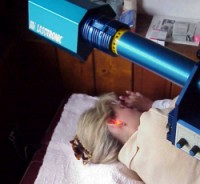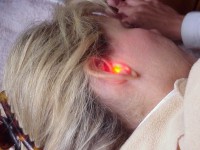
 |
||||||||||
|
||||||
The Inner Ear and Low Level Laser Therapy
|
||||||
 |
 |
|||||
|
The Inner Ear and Low Level Laser Therapy The inner ear is a highly complex, delicate organ, which enables us to orientate ourselves in space through sound and balance. Any compromise of this organ's function constitutes a serious and often excruciating impairment of the affected person`s health. At the same time, we are living in an era that puts this organ under particular stress.
Consequently, an ever increasing number of people at an increasingly younger age suffer from inner ear dysfunction. This dysfunction is the object of a multitude of speculations. Many therapies are offered. Many are invasive and their effects are questionable. The consumer and health care provider remains confused.
Here are some basic facts: Function and dysfunction of the inner ear Dr. Lutz Wilden in Bad Fuessing, Germany, has made truly ground breaking discoveries in his clinical work that explain the effectiveness of Low Level Laser Therapy in improving and restoring normal cell function in the inner ear. The following is based on his research and clinical data. The inner ear contains two sensory organs:
In the cochlea, the waves of vibration (sound) mechanically transmitted there via the eardrum and the ossicles (middle ear) are first compressed by means of a highly complex fluid system and then converted into electro-physiologic impulses that are passed on to the central nervous system. This conversion process can be explained in detail with today´s biological knowledge. It takes place in the auditory cells of the cochlea and is connected with movements of hairlike receptors on the cellular membrane and other processes within the cells of the inner ear. For this to happen properly the auditory cell requires energy in the form of ATP. ATP is produces by the mitochondria (cellular power plants) inside each cell. Hearing/Sound If the cochlea is acutely or chronically over strained, its sensory (auditory) cells and their various cellular organs are affected as well, and they inevitably lose part of their functional capacity. The cells are suffering from a lack of ATP. A continuous lack of ATP within the inner ear cells of the cochlea leads to either a gradual or sudden impairment of the entire hearing organ. This is experienced by the patient as acute or insidious symptoms:
Balance In the semicircular canals of the organ of balance, any changes in the position of our head and body are also conveyed via a fluid system and the movements of hairlike receptors. For this reason the ATP-consuming processes within the cells in question are almost identical to those in the cochlea during the act of hearing: mechanically transmitted motions are first converted into electro-physiologic impulses and then passed on to the central nervous system. A continuous lack of ATP within the inner ear cells of the labyrinth leads to either a gradual or sudden impairment of the entire organ of balance. This is experienced by the patient as acute or insidious symptoms:
In addition to their similar functional properties, the labyrinth and the cochlea are connected by means of a common fluid system. This is why inner ear diseases often affect both organs at the same time and show a large variety of symptoms. It goes without saying, of course, that - just as with any other illness - the extent of the respective impairment varies from person to person as well. But although these factors result in individually different healing processes, the low level laser therapy is able to produce a positive biological reaction regardless of the dysfunction involved. This is due to its elementary and biologically compelling working mechanism. On account of the basic conception of our cellular energy-converting system (collector principle), the electromagnetic energy released by the oxidation of nutrients is utilized as a source of primary energy for the production of the cellular fuel ATP. The antennae of the mitochondria can - in addition to the absorption of the released metabolic energy - utilize both the photons of the natural solar radiation (apparent bio-stimulative effect of sunlight on human cells) and the photons of low level laser light (clinically proven bio-stimulative effect of low level laser light on human cells) as a source of primary energy. Information on Low Level Laser Therapy (LLLT)
|
||||||
About Thorne ||About Sanum/Pleomorphic || Privacy Policy || Secure Shopping || Shipping |Contact Us |Site Map | Dr. Z's Dynamic Newsletter The statements in this website have not been evaluated by the Food and Drug Administration. These products are not intended to diagnose, treat, cure or prevent any disease. |
|||||
| © Copyright - Dr. Z - Peter Zeischegg , MS, DC, DACNB, 2013 | |||||